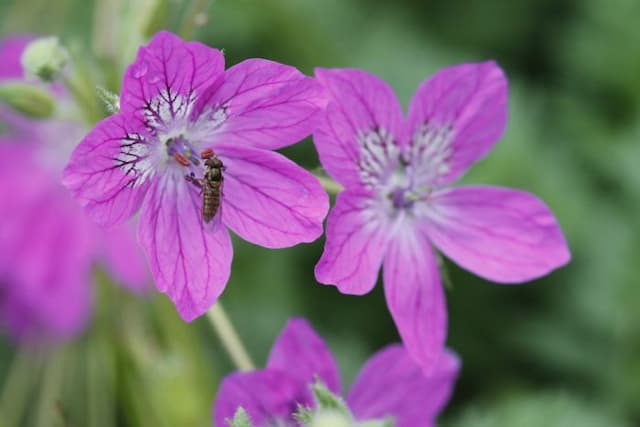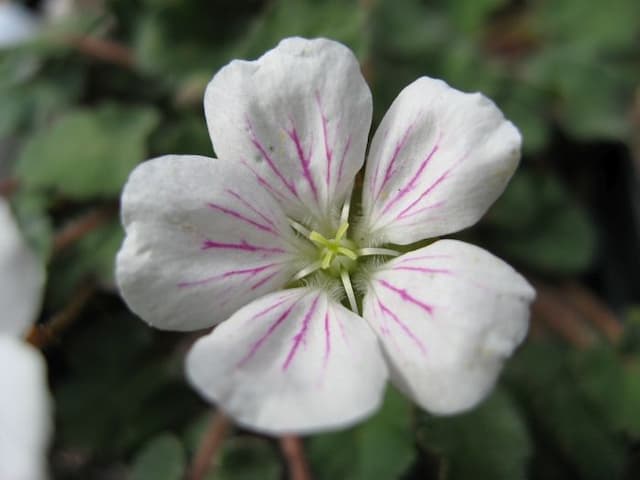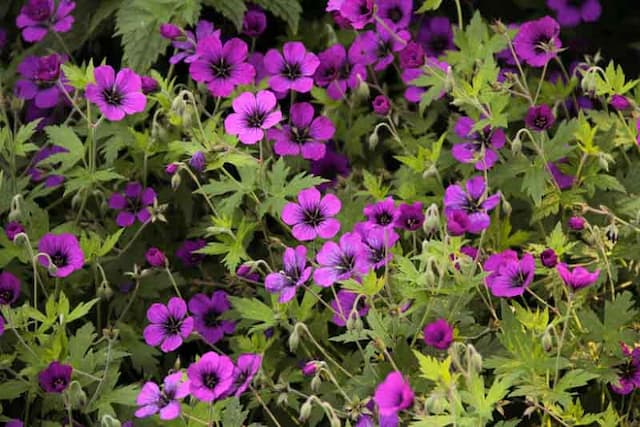Geranium Pelargonium 'Irene Cal' (Z/d)

ABOUT
Pelargonium 'Irene Cal', commonly referred to as geranium 'Irene Cal', is a striking plant known for its vibrantly hued blossoms and attractive foliage. The flowers are the most captivating feature, presenting in eye-catching shades that range from pinks to reds or purples. Each blossom is composed of rounded petals that may exhibit subtle, pleasingly contrasting veining or margins, adding depth and interest to the floral display. The leaves of this geranium are equally charming, typically green with a unique zonal pattern that may be darker in the center, creating a bullseye effect that is characteristic of many geranium varieties. The foliage has a soft, sometimes velvety texture and is often broadly rounded with scalloped or lobed edges that give them an ornate appearance. When in full bloom, the geranium 'Irene Cal' provides a lush and full display, with flowering heads held aloft on sturdy stalks that emerge from the dense foliage. The overall impression is one of a robust and cheerful plant that is well-suited to adding a pop of color and a touch of classic beauty to any garden display, container, or as an adornment for a sunny windowsill.
About this plant
 Names
NamesSynonyms
Irene Cal Geranium
Common names
Pelargonium 'Irene Cal'
 Toxicity
ToxicityTo humans
Geraniums are generally considered non-toxic to humans. However, some people may experience mild irritation or an allergic reaction when handling the plant or its sap due to sensitivity. Ingestion of geraniums is not usually associated with severe symptoms, but it can potentially cause minor gastrointestinal upset such as nausea or vomiting if eaten in large quantities.
To pets
Geraniums can be toxic to pets, particularly to dogs and cats. If a pet ingests a geranium, they might show symptoms of poisoning which include vomiting, depression, anorexia, and dermatitis. In more severe cases, ingestion can potentially lead to more serious effects such as generalized muscle weakness and even hypothermia. It is advisable to keep geraniums out of reach of pets to prevent accidental consumption.
 Characteristics
CharacteristicsLife cycle
Perennials
Foliage type
Evergreen
Color of leaves
Green
Flower color
Mixed
Height
1-2 feet (30-60 cm)
Spread
1-2 feet (30-60 cm)
Plant type
Herb
Hardiness zones
10
Native area
South Africa
Benefits
 General Benefits
General Benefits- Decorative Aesthetics - Pelargonium 'Irene Cal' adds vibrant color and visual interest to gardens and indoor spaces.
- Easy Maintenance - This plant is known for being low maintenance, requiring minimal care.
- Drought Tolerance - It is relatively drought-resistant, making it ideal for dry or water-wise gardens.
- Pest Resistance - The plant has natural resistance to some pests, reducing the need for chemicals.
- Adaptability - Can adapt to a variety of soil types as long as they are well-draining.
- Long Blooming Period - Offers a long season of blooms, providing color for an extended period.
- Attracts Pollinators - The flowers can attract beneficial insects such as bees and butterflies.
 Medical Properties
Medical PropertiesThis plant is not used for medical purposes.
 Air-purifying Qualities
Air-purifying QualitiesThis plant is not specifically known for air purifying qualities.
 Other Uses
Other Uses- Potpourri Addition: Irene Cal geranium leaves can be dried and included in potpourri mixes for their pleasant scent and decorative appearance.
- Aromatherapy: The essential oil from Irene Cal geraniums can be used in aromatherapy diffusers to offer a calming and uplifting ambiance.
- Natural Dye: The petals of Irene Cal geraniums can be used to create a natural dye for fabrics or crafts, providing a soft, earthy hue.
- Garden Companion Planting: Irene Cal geraniums can be planted alongside vegetables and herbs to help deter pests due to their strong scent.
- Culinary Garnish: Although not commonly consumed, the petals of Irene Cal geraniums can be used as a colorful and edible garnish for desserts or cocktails.
- Floral Arrangements: The flowers of Irene Cal geraniums can be used in floral arrangements to add color and a delicate fragrance.
- Educational Resource: Irene Cal geraniums can be used in schools or educational programs to teach about plant growth, reproduction, and horticulture.
- Photography Subject: With their bright blooms, Irene Cal geraniums make an excellent subject for botanical photography and art.
- Plant Therapy: Gardening with Irene Cal geraniums is often seen as therapeutic, improving mental health and providing a sense of accomplishment.
- Creative Crafts: The leaves and flowers of Irene Cal geraniums can be used in creative crafts like pressed flower art or botanical papermaking.
Interesting Facts
 Feng Shui
Feng ShuiThe Geranium is not used in Feng Shui practice.
 Zodiac Sign Compitability
Zodiac Sign CompitabilityThe Geranium is not used in astrology practice.
 Plant Symbolism
Plant Symbolism- Comfort: As a variety of geranium, the Pelargonium 'Irene Cal' is often associated with comfort and solace, perhaps due to its homey feel and pleasant scent which can have a calming effect.
- Friendship: Geraniums in general represent companionship or friendship, which may be a reflection of their long-lasting nature and the way they are commonly gifted between friends.
- Health: Many geraniums, including Pelargonium 'Irene Cal', are believed to symbolize good health, probably because some varieties are used in traditional medicines and aromatherapy.
- Sturdiness: Due to their hardy and adaptable nature, geraniums often stand for sturdiness and resilience, capable of thriving in a variety of conditions.
- Fertility: The robust growth and consistent flowering of geraniums can be seen as symbols of fertility and abundance.
 Water
WaterGeraniums, including the Pelargonium 'Irene Cal', should be watered thoroughly when the top inch of soil feels dry to the touch. Typically, this means watering every 7 to 10 days, but this can vary depending on environmental conditions such as temperature and humidity. Water the plant with approximately 8-16 ounces of water, ensuring that the soil is moistened evenly. Avoid wetting the leaves to prevent disease, and allow the excess water to drain away to prevent root rot. During the winter months, reduce watering to compensate for slower growth.
 Light
LightGeraniums prefer bright, indirect sunlight and should be placed in a spot where they can receive at least 4-6 hours of sunlight daily. An east- or west-facing window where they are shielded from the harsh afternoon sun is ideal. Avoid placing your Geranium in full shade as this can lead to leggy growth and fewer blooms.
 Temperature
TemperatureGeraniums thrive in temperatures between 65°F and 75°F during the day, and they prefer cooler temperatures at night, around 55°F to 65°F. Do not expose the plant to temperatures below 30°F as it can be damaged by frost. The Geranium's ideal growing conditions exclude extreme temperatures; both excessive heat above 85°F and cold drafts should be avoided for optimal health.
 Pruning
PruningPruning Geraniums helps to promote bushy growth and remove dead or yellowing leaves and spent blooms to encourage further flowering. Prune the plant lightly throughout the growing season as needed, and more extensively in late winter or early spring to prepare for new growth. The best time for major pruning is just before the plant resumes active growth, which is typically in early spring.
 Cleaning
CleaningAs needed
 Soil
SoilThe best soil mix for Geranium 'Irene Cal' is a well-draining potting mix composed of peat, compost or well-rotted manure, and perlite or sand to improve drainage. A slightly acidic to neutral pH between 5.8 and 7.2 is ideal for this plant.
 Repotting
RepottingGeranium 'Irene Cal' should typically be repotted every two to three years to ensure it has enough room for growth and fresh soil for nutrients.
 Humidity & Misting
Humidity & MistingGeranium 'Irene Cal' prefers moderate humidity levels but is adaptable; aim for a range between 40-60%.
 Suitable locations
Suitable locationsIndoor
Place in bright light, away from drafts, and water when soil feels dry.
Outdoor
Full sun to part shade and protect from frost; keep well-watered.
Hardiness zone
10-11 USDA
 Life cycle
Life cyclePelargonium 'Irene Cal', commonly known as zonal geranium, begins its life cycle with seed germination, where the seeds sprout and develop into seedlings when exposed to the right temperature and moisture conditions. The next stage is the vegetative growth phase, where the seedlings grow into mature plants with a robust root system, stems, and leaves through photosynthesis and nutrient uptake. Following the vegetative stage, the plant enters the flowering phase, where it produces clusters of flowers that can vary in color, with 'Irene Cal' often showcasing vibrant blooms. After pollination, which can be facilitated by insects or wind, the plant sets seeds within the spent flowers, completing the reproductive cycle. Finally, if conditions become unfavorable, such as in regions with cold winters, the plant may enter a period of dormancy or die back, awaiting favorable conditions to regrow if it is a perennial variety or concluding its life cycle if it is an annual.
 Propogation
PropogationPropogation time
Spring-Early Summer
The most popular method of propagating the Pelargonium 'Irene Cal', commonly known as geranium, is through stem cuttings. This is typically done in late summer to early fall to allow for enough time for the cuttings to establish roots before the growth period in spring. A healthy, non-flowering stem is chosen and cut at a length of 4 to 6 inches (about 10 to 15 centimeters) with a sharp, clean knife or scissors. The lower leaves are removed, leaving two or three leaves at the top. The cut end is often dipped in rooting hormone to encourage root growth and then the cutting is planted in a well-draining potting mix. The cutting should be kept in a bright area with indirect sunlight and the soil should be kept moist but not waterlogged until strong roots have formed, which usually takes a few weeks.









![Cranesbill [Rothbury Gem]](/_next/image?url=https%3A%2F%2Fplants-admin.emdemapps.com%2Fimages%2Fplants%2F%2Fimages%2F604b6243984c2.png&w=640&q=75)